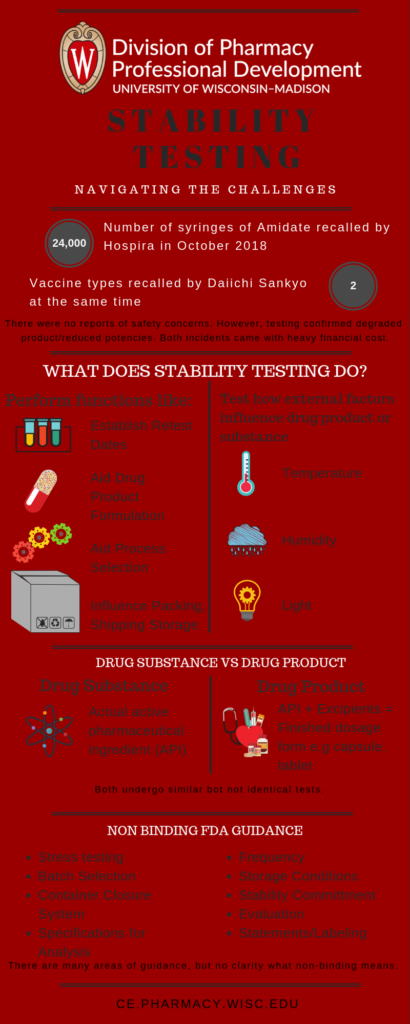Navigating the Challenges of Stability Testing
In October 2018 Hospira voluntarily recalled more than 24,000 syringes of the injectable “Amidate.” The stability testing confirmed out of specification results for a degraded product. Daiichi Sankyo also voluntarily recalled two vaccines in October due to reduced potencies. There were no reports of efficacy or safety concerns. The drugs were pulled as a precautionary measure. In each case, there were no resulting shortages impacting patients. However, there was a financial cost to both companies.
The Importance of Stability Testing
Drug development requires more than creating an efficacious compound. The drug substance must reach its target and be stable when administered. The drug product must remain stable during transport, distribution, and storage.
Sometimes the environment can be strictly controlled. Many times though, a drug product can be exposed to extreme conditions before being administered. A patient may forget their prescription in a car. This can expose the product to extreme sun and heat in some parts. In other situations, the product may be subjected to extreme cold. Humidity also varies by region. Florida can be hot and humid with 100-degree temperatures. Arizona can also hit 100 degrees but the air is extremely dry. Uncontrolled environments make stability testing important. Stability testing determines what conditions may cause the drug substance and drug product to degrade.
Stability testing is an important part of the life cycle of a pharmaceutical product. It plays a key role during development, regulatory review and commercialization.
Stability testing is used to perform various functions including:
- Establishing retest dates for drug substances
- Aiding drug product formulation
- Aiding process selection
- Influencing commercial packaging, shipping, and storage
Stability testing shows how the quality of a drug substance or drug product varies with time under the influence of a variety of factors like
- Temperature
- Humidity
- Light
This information helps establish a retest period for the drug substance. Stability testing also establishes expiration dates or recommended storage condition for drug products.
Stability Testing: Drug Substance vs Drug Product
Drug substance and drug product are not the same. The drug substance is the active pharmaceutical ingredient (API) without excipients. The drug product is the finished dosage form that contains the drug substance.
Drug substance is obtained early in drug development. It is obtained after candidate selection but before drug product development. It is important to understand the drug substance’s physiochemical properties before developing drug product. Biorelevant solubility testing of the drug substance is done to understand the compound’s solubility. Information on physiochemical properties and solubility guides the formulation strategy.
Once drug substance is developed and formulated for drug product, the drug product can be developed and tested. The drug product can be tested in suitable media for dissolution testing prior to clinical studies. Biorelevant dissolution testing will give insight as to how the drug product will dissolve in vivo. Thus, drug substance and drug products undergo similar, but not identical stability testing regimens.
Regulatory Guidance on Stability Testing
The FDA provides non-binding guidance for a stability data package for new drug substances or drug products registered in the European Union (EU), Japan, and the United States. Its most recent version was published in 2003. It covers topics for drug substance including:
- Stress Testing
- Batch Selection
- Container Closure System
- Specifications for analysis
- Frequency
- Storage Conditions
- Stability Commitment
- Evaluation
- Statements/Labeling
For drug products, the guidance covers similar topics but replaces stress testing with photostability testing. However, the recommendations provided by this guidance are non-binding. What do they actually mean? How much testing is enough? What are the current regulatory perspectives on drug product stability testing? How to use stability data as part of a science and risk-based approach to establish specifications?
There are many questions about stability testing best practices. Regulatory agencies provide guidelines, but no definitive answers. Many pharmaceutical companies are trying to navigate stability testing with their best guesses.
Announcing Stability Testing Series
Our new “Stability Testing Series” will help pharmaceutical scientists navigate stability testing. This 4 part 90 minute lecture series will be presented by Dr. Ocheltree. Dr. Terry Ocheltree, a veteran of the FDA and Industry with over 30 years of experience. He will provide solutions to common stability testing problems. Participants can attend one or more lectures in the series depending on their interest.
